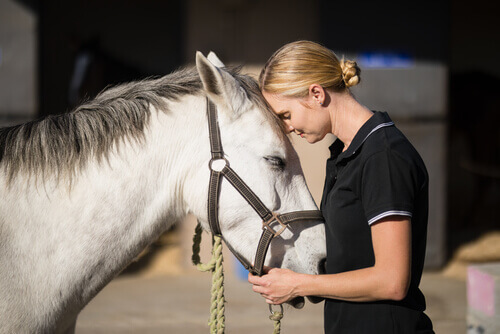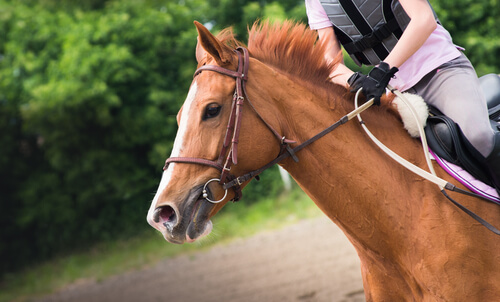Tips on Taming a Horse

Horses have been companions to humans for a very long time, along with dogs and cats. Their elegance and loyalty are incomparable. However, to train a horse, you need great patience and respect. In this article, we’ll give you advice on taming a horse.
Our fast companions
Believe it or not, every horse has a different personality. As a result, although you may have similar relationships with your horses, the results with each horse might be different.
However, the process of taming a horse is similar to each individual. There will be a difference in the intensity of the exercises. Taming a horse requires patience for both the horse and the tamer. We’re definitely not talking about a quick process here!
So if you’re planning on taming a horse quickly, keep in mind that this process usually lasts at least a year. Of course, the experience is ultimately worth it.
Steps for taming a horse
First, you need to create a bond with the horse. The ideal outcome is that you’re able to gain their trust and make them feel safe. This is essential to help them understand that you’re not a threat and that they can trust you during this process.

To do this, you should use different methods of interacting with your horse. For example, you can start by calling them with soft sounds like clicks and whistles. You should speak softly and gently. Don’t make loud or sudden sounds that may scare the horse.
You should never approach the horse if they don’t approach you as well of their own free will. In fact, you should always observe the movements of their body and how they look at you. Ideally, you should let the horse approach you on their own and greet you with affection. Your horse will show them by bowing their head towards you.
You should never hit or intimidate your horse in any way. These actions only delay the process further. In fact, they can even make the situation worse. Instead, you should always treat them with respect. Also, let your horse keep in you in their vision at all times. Avoid coming up to your horse from behind.
To further strengthen your bond, try giving your horse some grass and water while petting them. They will associate this with goodwill and may become more submissive to you. Once you think you’ve earned their trust, it’s time to move on to the next stage.
The second step of taming a horse
This stage consists of getting a horse used to someone riding them. You want the animal to get to a stage where they’re not nervous about having all the equipment and a rider on their back. Similarly, you want them to get used to obeying orders and following your directions without hesitation.

To start, you need to get them accustomed to the halter. This is the piece that goes on their muzzle and head. This equipment allows the rider to maneuver the horse easily. However, you can’t put this piece on right away. Instead, you should let your horse smell it, look at it, and become familiar with it first.
Then, when you think your horse is ready, it’s time to put on the halter and verify that they’re comfortable with it. If you see that your horse is calm, this is a really good sign. However, if your horse is nervous or seems impatient, it’s best to remove the halter immediately and try again another day.
Then, you should follow the same process with every other element that you’ll place on the horse’s head, such as the flange, mouthpiece, and blinkers. Once your horse is comfortable with each piece, then it’s time to continue to the next phase.
Getting your horse used to the rein
This accessory is a way to encourage your horse to obey you and feel compelled to follow you. Instead, you want to help guide them. Try guiding them for a few feet in a circle without forcing them to do anything and without raising your voice.

At the same time, we recommend giving them some vocal commands. Then, your horse will understand when to stop and when to move, along with other actions. Once you think your horse is ready, it’s time to move on to the last stage of training.
The saddle and other elements
As you’ve done with the other items, you should introduce each piece one by one. Let your horse become familiar with them first by examining them and smelling them. For example, in the case of the saddle, you shouldn’t attempt to use it the first time you put in on your horse. Instead, just place it on and let them get used to it.
For example, you should never adjust the straps tightly the first time you put it on. This will only scare your horse and make the process longer. Instead, you should adjust the pressure little by little over time to prevent your horse from becoming nervous.
Once you manage to get your horse comfortable with all the equipment and are able to mount your horse, you should give yourself a huge round of applause! Taming a horse is not an easy task. Now, you should continue your training so your horse is able to perform any tasks you want.
Horses have been companions to humans for a very long time, along with dogs and cats. Their elegance and loyalty are incomparable. However, to train a horse, you need great patience and respect. In this article, we’ll give you advice on taming a horse.
Our fast companions
Believe it or not, every horse has a different personality. As a result, although you may have similar relationships with your horses, the results with each horse might be different.
However, the process of taming a horse is similar to each individual. There will be a difference in the intensity of the exercises. Taming a horse requires patience for both the horse and the tamer. We’re definitely not talking about a quick process here!
So if you’re planning on taming a horse quickly, keep in mind that this process usually lasts at least a year. Of course, the experience is ultimately worth it.
Steps for taming a horse
First, you need to create a bond with the horse. The ideal outcome is that you’re able to gain their trust and make them feel safe. This is essential to help them understand that you’re not a threat and that they can trust you during this process.

To do this, you should use different methods of interacting with your horse. For example, you can start by calling them with soft sounds like clicks and whistles. You should speak softly and gently. Don’t make loud or sudden sounds that may scare the horse.
You should never approach the horse if they don’t approach you as well of their own free will. In fact, you should always observe the movements of their body and how they look at you. Ideally, you should let the horse approach you on their own and greet you with affection. Your horse will show them by bowing their head towards you.
You should never hit or intimidate your horse in any way. These actions only delay the process further. In fact, they can even make the situation worse. Instead, you should always treat them with respect. Also, let your horse keep in you in their vision at all times. Avoid coming up to your horse from behind.
To further strengthen your bond, try giving your horse some grass and water while petting them. They will associate this with goodwill and may become more submissive to you. Once you think you’ve earned their trust, it’s time to move on to the next stage.
The second step of taming a horse
This stage consists of getting a horse used to someone riding them. You want the animal to get to a stage where they’re not nervous about having all the equipment and a rider on their back. Similarly, you want them to get used to obeying orders and following your directions without hesitation.

To start, you need to get them accustomed to the halter. This is the piece that goes on their muzzle and head. This equipment allows the rider to maneuver the horse easily. However, you can’t put this piece on right away. Instead, you should let your horse smell it, look at it, and become familiar with it first.
Then, when you think your horse is ready, it’s time to put on the halter and verify that they’re comfortable with it. If you see that your horse is calm, this is a really good sign. However, if your horse is nervous or seems impatient, it’s best to remove the halter immediately and try again another day.
Then, you should follow the same process with every other element that you’ll place on the horse’s head, such as the flange, mouthpiece, and blinkers. Once your horse is comfortable with each piece, then it’s time to continue to the next phase.
Getting your horse used to the rein
This accessory is a way to encourage your horse to obey you and feel compelled to follow you. Instead, you want to help guide them. Try guiding them for a few feet in a circle without forcing them to do anything and without raising your voice.

At the same time, we recommend giving them some vocal commands. Then, your horse will understand when to stop and when to move, along with other actions. Once you think your horse is ready, it’s time to move on to the last stage of training.
The saddle and other elements
As you’ve done with the other items, you should introduce each piece one by one. Let your horse become familiar with them first by examining them and smelling them. For example, in the case of the saddle, you shouldn’t attempt to use it the first time you put in on your horse. Instead, just place it on and let them get used to it.
For example, you should never adjust the straps tightly the first time you put it on. This will only scare your horse and make the process longer. Instead, you should adjust the pressure little by little over time to prevent your horse from becoming nervous.
Once you manage to get your horse comfortable with all the equipment and are able to mount your horse, you should give yourself a huge round of applause! Taming a horse is not an easy task. Now, you should continue your training so your horse is able to perform any tasks you want.
This text is provided for informational purposes only and does not replace consultation with a professional. If in doubt, consult your specialist.








